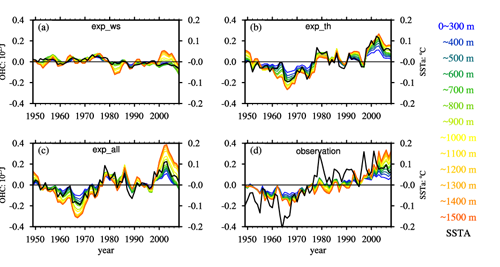Simulated heat sink in the Southern Ocean and its contribution to the recent hiatus decade
Date:2015-04-21
Three numerical experiments with different surface forcing strategies were carried out to investigate the combined and individual contributions of wind stress and thermohaline forcing to the heat sink in the Southern Ocean in the recent hiatus decade, using an oceanic general circulation model (PCOM). The combined-forcing experiment simulated a significant heat sink in the Southern Ocean in the recent hiatus decade, well match the observations. The results also showed that thermohaline forcing is dominant in the heat exchange between the Southern Ocean and its overlaying atmosphere in the upper layers. In intermediate layers, wind stress forcing also plays an important role. The mechanism for the different contributions of the two types of forcing may be due to different physical processes for the heat budget: In the thermohaline forcing, the heat budget is maintained mainly by vertical mixing in the upper layers, while in the wind stress forcing it is maintained mainly Sverdrup dynamics.

Integrated ocean heat content (OHC) from the surface to different indicated depths in the Southern Ocean for (a) Exp_ws, (b) Exp_th, (c) Exp_all, and (d) observation. Shown is the yearly mean deviation for the whole period for each layer. Color lines show the OHC (left y-coordinate). The black line shows the SSTAs (right y-coordinate).
Citation: Ou N.-S., Y.-H Lin, and X.-Q. Bi, 2015: Simulated heat sink in the Southern Ocean and its contribution to the recent hiatus decade, Atmos. Oceanic Sci. Lett., 8, doi:10.3878/AOSL20150008.
Download: http://159.226.119.58/aosl/EN/abstract/abstract552.shtml#
